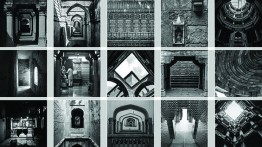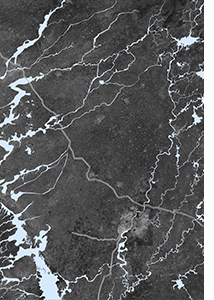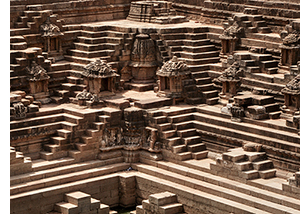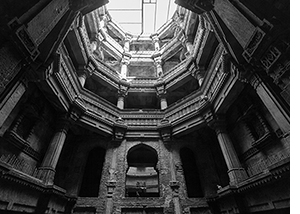Stepwells of Ahmedabad
Mon, Nov 2, 2020 12pm - Fri, Dec 4, 2020 5pm


Stepwells of Ahmedabad is an ongoing, collaborative research initiative by a group of architects from Ahmedabad, India. This online exhibition presents their work on stepwells, the subterranean water structures found extensively in the semi-arid region of western India (see Gallery 1). The region’s architectural vocabulary has evolved historically in response to seasonal water availability, resulting in various types of water harvesting structures, including stepwells (see Gallery 2). A typical stepwell consists of a deep well shaft that taps into groundwater, and a stepped corridor that descends several stories below ground to access the water. The corridor often served as a social space, particularly for local women and travelers. The product of five years of research conducted in the city of Ahmedabad in north central Gujarat, the group’s work is presented here in the form of thematic essays, drawings, maps, photographs, and videos. Now in its fourth iteration, this exhibition intends to raise awareness of larger concerns about water, settlement patterns, heritage, and social relationships tied to stepwells.

The process of locating extant stepwells involved directly engaging with communities, speaking with local experts, and researching archival texts, historical travel accounts, and old maps. Satellite imagery helped identify former historic settlements and their adjoining reservoirs, which often indicated the presence of stepwells. Some smaller stepwells were found unexpectedly during conversations with various people along the way, while others marked on old maps had been built over. It became apparent that the stepwells were a recurrent typology, deeply embedded in the city’s social and ecological rhythms. This reinforced the need to look beyond their role as relics, and to start a conversation about their unique legacy within the subcontinent’s larger culture of harvesting water.

The stepwells documented in this exhibition (see Gallery 3) were built between the 11th and 19th centuries in Ahmedabad’s walled city, its historic suburbs, hinterland settlements, and along the routes connecting these settlements. They worked in sync with seasonal rivers, streams, reservoirs, dug wells, and cisterns to support a regional nexus of dwelling, cultivation, craft, and trade for centuries. They were also deeply entwined in the social lives of women who performed the daily labor of fetching water for their households. In fact, more than a quarter of the region’s stepwells were commissioned and financed by women, challenging historical gender stereotypes (see Gallery 4). [1] In most regions of the Indian subcontinent, this connection between women and water is of continuing relevance, as women are disproportionately more vulnerable to acute water stress, and are often the first responders in times of drought, especially at the grassroots level. Thus, women in particular are well-positioned to be active stewards of shared water resources as we confront an acute regional water crisis.

As documented in the exhibition, the present conditions of Ahmedabad’s stepwells vary greatly (see Gallery 5). While the larger and more ornate stepwells have been preserved as monuments, many smaller structures have been integrated into the social lives of neighborhoods as temples enshrining local goddesses (maata). Other stepwells have physically degraded from years of neglect and misuse. Most no longer hold water due to the ecological disruptions of indiscriminate urban sprawl, overextracted groundwater reserves, and a complete collapse of the social structures that actively maintained and managed stepwells as their primary source of water. [2]

While Ahmedabad’s historic urban core has been recognized as India’s first UNESCO World Heritage City, the fast-growing metropolis has also become a testbed of experimental projects, policies, and mega infrastructure initiatives, as exemplified by the Sabarmati riverfront. By paving over the river’s natural floodplains, this project uses water aesthetically, politically, and symbolically to meet perennial water demands. However, there is a stark disparity and a growing inequality around access to water for the city’s residents. [3] Current attitudes towards water raise questions about the challenges presented by planning, constructing, and managing a centralized water infrastructure premised on indefinite extraction to support urban expansion. As the city negotiates its position between reckoning with its heritage and planning for massive infrastructure development to serve a growing population, it is critical to acknowledge and respond to larger ecological patterns, as expressed in the legacy of water harvesting that sustained life in this region for centuries.
Register for an online lecture from the curators on December 1.
[1] Purnima Mehta-Bhatt, Her Space, Her Story (Zubaan, 2014).
[2] David Hardiman, “Well Irrigation in Gujarat: Systems of Use, Hierarchies of Control,”
Economic and Political Weekly, June 20, 1998, 13.
[3] Bela Bhatia, “Lush Fields and Parched Throats: The Political Economy of Groundwater in
Gujarat,” 1992, 143.
Credits
Research, Drawings, and Curation: Priyanka Sheth, Tanvi Jain, and Aashini Sheth
Photography: Malay Doshi and Karan Gajjar
Core Team: Priyanka Sheth, Tanvi Jain, Aashini Sheth, Neel Jain, and Malay Doshi
The Stepwells of Ahmedabad initiative was launched in 2015 by Riyaz Tayyibji of Anthill Design, which has been instrumental in conceiving, curating, and evolving the initiative’s research. The exhibition is indebted to many students, academics, scholars, researchers, and the people of Ahmedabad who have created a knowledge ecosystem for understanding the city and its environs, where the initiative germinated and continues to grow with each iteration.
Thank you to The Irwin S. Chanin School of Architecture and the School’s Architecture Archive for hosting this exhibition, and to Professor Anthony Vidler for his energy, participation, and support.
Unless otherwise noted, all images, text, and drawings © Stepwells of Ahmedabad, 2020.




